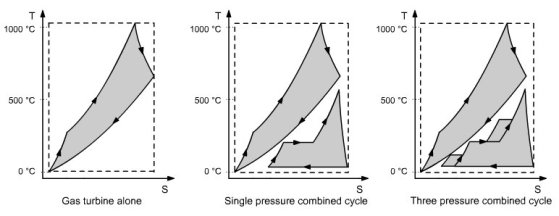Combined cycles
Principle of operation
The principle of a combined cycle is to operate in cascade one or more gas turbines, followed by a steam power plant whose heat source is the cold source of gas turbines.
Under these conditions, the gas turbine exhaust gas is recovered in a recovery boiler that produces steam that is then expanded in a condensing turbine. The combined cycle thus obtained is a particularly successful marriage in the search for improved thermal performance: with currently available machines, efficiencies exceed 55% and are higher than those we can hope, even in the medium term, of the most advanced future steam plants.

Many innovative cycles are based on the concept of the combined cycle. You will find various examples in this portal, particularly in the thematic pages on oxycombustion cycles .
Heat recovery steam generator
The thermodynamic analysis of the combined cycleshows that it is as important to optimize the steam cycle as the heat recovery steam generator (HRSG), and thus its effectiveness epsilon. The difficulties arise because the problem is highly constrained and there may be conflict between these two objectives. A page of this portal presents this issue.
If we represent in an enthalpy diagram changes in temperature in a HRSG, the vein of hot gases, orange, cools approximately linearly with the heat it yields, while the steam heating curve has its characteristic shape in blue, due to the vaporization plateau.
The irreversibility of the cycle are an increasing function of the area between the two curves in the diagram.

Multi-pressure HRSG
To improve the cycle performance, we can use multiple steam cycles at different pressure levels (two, three or even four). The figure below shows the value of using multi-level pressure: with some simplifying assumptions and a choice of scales, we can superimpose on an entropy chart gas turbine and steam power plant cycles. In all three cases, the grey surface represents work provided for the same heat input in the gas turbine. The rectangle in the dashed line is the Carnot cycle.
The left figure corresponds to a single gas turbine, the middle to a single pressure combined cycle, and the right to a three pressure combined cycle.
The gain provided by the increased number of pressure levels is very clear, but designing the HRSG is a complex optimization problem and quite new, which does not arise in conventional boilers.

The optimization of such cycles is a complex problem, because to get the better cooling of the hot gas stream, there are many degrees of freedom on the pressure levels, on the corresponding flow rates, and on placement of heat exchangers (in series or in parallel).
The Thermoptim optimization method , based on the pinch method, is especially well suited to address this problem.
Book reference
An excerpt of the textbook chapter is freely downloadable with the agreement of CRC Press
Available Diapason session
The Diapason session dealing with combined cycles based on open cycle gas turbines is given in the table below. Session S41En is an exercise allowing you to design a single pressure combined cycle.
n° | content | steps | soundtrack duration |
|---|---|---|---|
S41En | 13 | 7 mn 50 s |
Guipe page for practical work
The optimization of such cycles is a complex problem, because to get the better cooling of the hot gas stream, there are many degrees of freedom on the pressure levels, on the corresponding flow rates, and on placement of heat exchangers (in series or in parallel).
The Thermoptim optimization method , based on the pinch method, is especially well suited to address this problem. The guide for practical work FG11 is devoted to this issue, and you will find several pages devoted to this subject in a section of the methodological guide.
